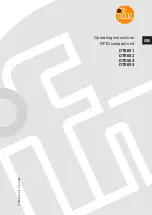
SECTION 2 - PROCEDURES
3120686
– JLG Lift –
2-53
5.
Telescope the boom until the leading edge of the red
marking tape is exposed from the mid boom. Adjust
potentiometer P2 until the red light just turns on and
the blue lights turns off.
6.
Measure the voltage at TP2. Adjust potentiometer P4
until the voltage at TP7 measures 0.05 Volts DC
more than the voltage at TP2. This determines the
length of the boom (critical length) where the lift
down speed limiter is turned on.
Operational Check
1.
Raise the boom completely and fully extend the
boom.
2.
Engage auxiliary power.
3.
Engage LIFT DOWN until blue light turns off and red
light turns on. When red light turns on, shut down
machine and check boom angle. Boom angle
should be 64 degrees - 67 degrees. If boom angle is
within this range, the boom angle/length indicator
system is operating properly and requires no further
adjustment. If the boom angle is not within this
range, contact the JLG Service Department for fur-
ther assistance.
Lift Down Speed Limit Adjustment
1.
On lift down speed limit circuit card, measure volt-
age at TP3. Adjust R1 until 8.0 Volts is obtained.
2.
Measure voltage at TP1. Adjust R17 until 3.0 Volts is
obtained.
2.26 LOAD MANAGEMENT SYSTEM
The LMS (Load Management System) consists of three
independent systems.
Platform Position Indication System
This system illuminates one of the two lamps in the plat-
form position display located on both the platform console
and ground control box. A blue light is used to indicate
that the platform is within the permitted operating enve-
lope and a red light is used to indicate when the platform
is outside the permitted operating envelope. Either the
blue or red light should be illuminated at all times.
The elevation angle is sensed by means of a pendulum
potentiometer and the extension of the boom sensed by a
multi-turn potentiometer driven by means of a cable
attached to the telescoping part of the boom. Both of
these sensors are situated at the rear of the base boom
section and housed in a sealed steel box.
The signals from these sensors (elevation angle and
extension distance) are fed into a load radius card which
calculates the boom radius.
Boom Radius = Boom Length x Cos Boom Angle
View thousands of Crane Specifications on FreeCraneSpecs.com
View thousands of Crane Specifications on FreeCraneSpecs.com
















































